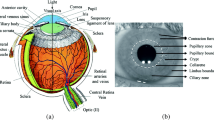Abstract
This paper presents a study of a class of iris localization algorithms in the presence of blurring. The effect of blurring is a serious problem in most image processing systems. It may originate in iris imaging systems due to out-of-focus effect. It affects the features extracted from the iris images. Hence, the objective of this paper is to study the sensitivity of three popular iris localization algorithms to the presence of blurring. Features are extracted from normal as well as blurred iris images and used for iris localization. Moreover, Wiener filter restoration is used as a tool to combat the effect of blurring. Performance of the compared iris localization algorithms with Wiener filter restoration is also studied. Simulation results reveal that Masek iris localization algorithm has the least sensitivity to the blurring effect. Its accuracy without blurring is 88.2%, and with blurring, it decreases to 68.18%. Moreover, the Wiener filter significantly improves the accuracy of iris localization.














Similar content being viewed by others
References
Essam, M., Fikri, M., Abd Elnaby, M., & Abd El-Samie, F. E. (2012). A fast accurate algorithm for iris localization using a coarse-to-fine approach. In Japan–Egypt conference on electronics, communications and computers (pp. 75–79).
Wayman, J., Jain, A., Maltoni, D., & Maio, D. (2005). Biometric systems. London: Springer.
Essam, M., Fikri, M. Abd Elnaby, M., & Abd El-Samie, F. E. (2012). An efficient iris localization algorithm. In 29th National radio science conference, Egypt (NRSC 2012), (pp. 285–292).
Daugman, J. (2004). How iris recognition works. IEEE Transaction on Circuits and Systems for Video Technology, 14(1), 21–30.
Soliman, N., Essam, M., Magdi, F., Abd El-Samie, F., & AbdElnaby, M. (2016). Efficient iris localization and recognition. International Journal for Light and Electron Optics, 140, 469–475.
Wildes, R. (1997). Iris recognition: an emerging biometric technology. Proceedings of the IEEE, 85(9), 1348–1363.
Liu, X., Bowyer, K., & Flynn, P. (2005). Experiments with an improved iris segmentation algorithm. In Automatic identification advanced technologies. Fourth IEEE workshop.
Cherabit, N., Chelali, F., & Djeradi, A. (2012). Circular hough transform for iris localization. Science and Technology, 2, 114–121.
Li, C., Xu, C., Gui, C., & Fox, M. D. (2010). Distance regularized level set evolution and its application to image segmentation. IEEE Transaction on Image Processing, 19(12), 3243–4254.
Verma, P., Dubey, M., Basu, S., & Verma, P. (2012). Hough transform method for iris recognition-A biometric approach. International Journal of Engineering and Innovative Technology (IJEIT), 1(6), 43–48.
Nguyen, K., Fookes, C., Jillela, R., Sridharana, S., & Ross, A. (2017). Long range iris recognition: A survey. Pattern Recognition Journal, 72, 123–143.
Jan, F. (2016). Segmentation and localization schemes for non-ideal iris biometric systems. Signal Processing Journal, 133, 192–212.
Jan, F. (2016). Non-circular iris contours localization in the visible wavelength eye images. Computers and Electrical Engineering Journal, 62, 1–12.
Galdi, C., & Dugelay, J. (2017). FIRE: Fast Iris recognition on mobile phones by combining color and texture features. Pattern Recognition Letters, 91, 44–51.
Jain, A., Ross, A., & Prabhakar, S. (2004). An introduction to biometric recognition. IEEE Transactions on Circuits and Systems for Video Technology, 14(1), 4–20.
Djekoune, A., Messaoudi, K., & Amara, K. (2016). Incremental circle hough transform: An improved method for circle detection. International Journal for Light and Electron Optics, 133, 17–31.
Jiang, L., Wang, Z., Ye, Y., & Jiang, J. (2017). Fast circle detection algorithm based on sampling from difference area. International Journal for Light and Electron Optics, 158, 424–433.
Caselles, V., Catt, F., Coil, T., & Dibos, F. (1992). A geometric model for active contours in image processing. Numerische Mathematik, 66, 1–31.
Jarjes, A., Wang, K., & Mohammed, G. (2010). Iris localization: Detecting accurate pupil contour and localizing limbus boundary. In 2nd international Asia conference on informatics in control, automation and robotics (pp. 349–352)
Nixon, M., & Aguado, A. (2008). Feature extraction and image processing (2nd ed.). Oxford: Elsevier’s Science & Technology Rights Department in Oxford.
CASIA-IrisV3 database, available at: http://www.cbsr.ia.ac.cn/english/IrisDatabase.asp (Online, Accessed April 2015).
Masek, L. (2003). Recognition of human iris patterns for biometric identification, partial fulfillment of the requirements for the Bachelor of Engineering degree of the School of Computer Science and Software Engineering, The University of Western Australia.
Hsu, P., & Chen, B. (2008). Blurred image detection and classification, supported by the National Science Council of Taiwan under NSC95-2622-E-002-018.
Schettini, R., & Corchs, S. (2010). Underwater image processing: state of the art of restoration and image enhancement methods. EURASIP Journal on Advances in Signal Processing.
Lim, J. S. (1990). Two-dimensional signal and image processing. Department of Electrical Engineering and Computer Science Massachusetts Institute of Technology.
Vaseghi, S. (2000) “wiener filters”, Advanced digital signal processing and noise reduction, 2nd edn, ISBNs: 0-471-62692-9 (Hardback): 0-470-84162-1 (Electronic) (pp. 178–204).
El-Khamy, S. E., Hadhoud, M. M., Dessouky, M. I., Sallam, B. M., & Abd El-Samie, F. E. (2005). Enhanced wiener restoration of images based on the haar wavelet transform. International Journal of Information Acquisition, 2(3), 217–226.
El-khamy, S., Saad, E., Hadhoud, M., Dessouky, M. I., Abbas, A. M., & Abd El-Samie, F. E. (2005). A modified wiener filter for multi-frame restoration of blurred and noisy images. International Journal of Information Acquisition, 2(2), 123–135.
Author information
Authors and Affiliations
Corresponding author
Additional information
Publisher's Note
Springer Nature remains neutral with regard to jurisdictional claims in published maps and institutional affiliations.
Rights and permissions
About this article
Cite this article
Salah, M.M., Napoleon, S.A., El-Rabaie, ES.M. et al. Sensitivity Analysis of a Class of Iris Localization Algorithms to Blurring Effect. Wireless Pers Commun 104, 269–286 (2019). https://doi.org/10.1007/s11277-018-6019-4
Published:
Issue Date:
DOI: https://doi.org/10.1007/s11277-018-6019-4




